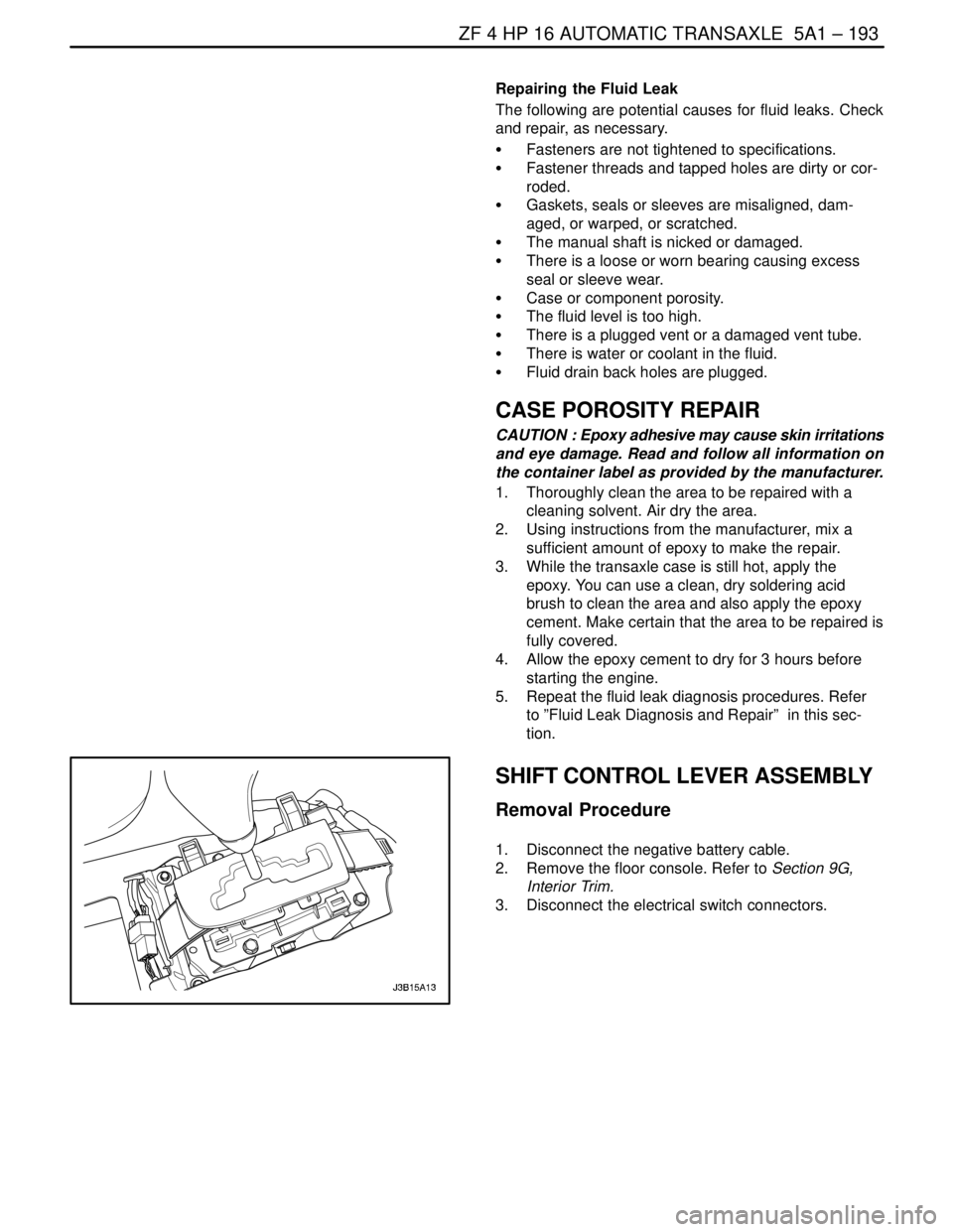2004 DAEWOO LACETTI coolant level
[x] Cancel search: coolant levelPage 1396 of 2643

ZF 4 HP 16 AUTOMATIC TRANSAXLE 5A1 – 47
DAEWOO V–121 BL4
Repairing the Fluid Leak
Once the leak point is found the source of the leak must
be determined. The following list describes the potential
causes for the leak:
S Fasteners are not torqued to specification.
S Fastener threads and fastener holes are dirty or
corroded.
S Gaskets, seals or sleeves are misarranged, dam-
aged or worn.
S Damaged, warped or scratched seal bore or gasket
surface.
S Loose or worn bearing causing excess seal or
sleeve wears.
S Case or component porosity.
S Fluid level is too high.
S Plugged vent or damaged vent tube.
S Water or coolant in fluid.
S Fluid drain back holes plugged.
ELECTRICAL/GARAGE SHIFT TEST
This preliminary test should be performed before a hoist
or road test to make sure electronic control inputs is con-
nected and operating. If the inputs are not checked before
operating the transaxle, a simple electrical condition could
be misdiagnosed as a major transaxle condition.
A scan tool provides valuable information and must be
used on the automatic transaxle for accurate diagnosis.
1. Move gear selector to P (Park) and set the parking
brake.
2. Connect scan tool to Data Link Connector (DLC)
terminal.
3. Start engine.
4. Turn the scan tool ON.
5. Verify that the appropriate signals are present.
These signals may include:
S ENGINE SPEED
S VEHICLE SPEED
S THROTTLE POSITION
S TRANSAXLE GEAR STATE
S GEAR SHIFT LEVER POSITION
S TRANSAXLE FLUID TEMPERATURE
S CLOSED THROTTLE POSITION LEARN
S OPEN THROTTLE POSITION LEARNT
S CLOSED ACCEL. PEDAL POSITION LEARNT
S OPEN ACCEL. PEDAL POSITION LEARNT
S A/C COMPRESSOR STATUS
S MODE SWITCH
S THROTTLE POSITION VOLTAGE
S GEAR SHIFT LEVER POSITION VOLTAGE
S TRANS. FLUID TEMPERATURE VOLTAGE
S A/C SWITCH
S MODE SWITCH VOLTAGE
S BATTERY VOLTAGE
6. Monitor the A/C COMPRESSOR STATUS signal
while pushing the A/C switch.S The A/C COMPRESSOR STATUS should come
ON when the A/C switch is pressed, and turns
OFF when the A/C switch is repushed.
7. Monitor the GEAR SHIFT LEVER POSITION signal
and move the gear shift control lever through all the
ranges.
S Verify that the GEAR SHIFT LEVER POSITION
value matches the gear range indicated on the
instrument panel or console.
S Gear selections should be immediate and not
harsh.
8. Move gear shift control lever to neutral and monitor
the THROTTLE POSITION signal while increasing
and decreasing engine speed with the accelerator
pedal.
S THROTTLE POSITION should increase with
engine speed.
ROAD TEST PROCEDURE
S Perform the road test using a scan tool.
S This test should be performed when traffic and road
conditions permit.
S Observe all traffic regulations.
The TCM calculates upshift points based primarily on two
inputs : throttle angle and vehicle speed. When the TCM
wants a shift to occur, an electrical signal is sent to the shift
solenoids which in turn moves the valves to perform the
upshift.
The shift speed charts reference throttle angle instead of
”min throttle” or ”wot” to make shift speed measurement
more uniform and accurate. A scan tool should be used to
monitor throttle angle. Some scan tools have been pro-
grammed to record shift point information. Check the
introduction manual to see if this test is available.
Upshift Procedure
With gear selector in drive(D)
1. Look at the shift speed chart contained in this sec-
tion and choose a percent throttle angle of 10 or
25%.
2. Set up the scan tool to monitor throttle angle and
vehicle speed.
3. Accelerate to the chosen throttle angle and hold the
throttle steady.
4. As the transaxle upshifts, note the shift speed and
commanded gear changes for :
S Second gear.
S Third gear.
S Fourth gear.
Important : Shift speeds may vary due to slight hydraulic
delays responding to electronic controls. A change from
the original equipment tire size affects shift speeds.
Note when TCC applies. This should occur in fourth gear.
If the apply is not noticed by an rpm drop, refer to the
”Lock–up Clutch Diagnosis” information contained in this
section.
Page 1542 of 2643

ZF 4 HP 16 AUTOMATIC TRANSAXLE 5A1 – 193
DAEWOO V–121 BL4
Repairing the Fluid Leak
The following are potential causes for fluid leaks. Check
and repair, as necessary.
S Fasteners are not tightened to specifications.
S Fastener threads and tapped holes are dirty or cor-
roded.
S Gaskets, seals or sleeves are misaligned, dam-
aged, or warped, or scratched.
S The manual shaft is nicked or damaged.
S There is a loose or worn bearing causing excess
seal or sleeve wear.
S Case or component porosity.
S The fluid level is too high.
S There is a plugged vent or a damaged vent tube.
S There is water or coolant in the fluid.
S Fluid drain back holes are plugged.
CASE POROSITY REPAIR
CAUTION : Epoxy adhesive may cause skin irritations
and eye damage. Read and follow all information on
the container label as provided by the manufacturer.
1. Thoroughly clean the area to be repaired with a
cleaning solvent. Air dry the area.
2. Using instructions from the manufacturer, mix a
sufficient amount of epoxy to make the repair.
3. While the transaxle case is still hot, apply the
epoxy. You can use a clean, dry soldering acid
brush to clean the area and also apply the epoxy
cement. Make certain that the area to be repaired is
fully covered.
4. Allow the epoxy cement to dry for 3 hours before
starting the engine.
5. Repeat the fluid leak diagnosis procedures. Refer
to ”Fluid Leak Diagnosis and Repair” in this sec-
tion.
SHIFT CONTROL LEVER ASSEMBLY
Removal Procedure
1. Disconnect the negative battery cable.
2. Remove the floor console. Refer to Section 9G,
Interior Trim.
3. Disconnect the electrical switch connectors.
Page 1591 of 2643

SECTION : 5A2
AISIN AUTOMATIC TRANSAXLE
CAUTION : Disconnect the negative battery cable before removing or installing any electrical unit or when a tool
or equipment could easily come in contact with exposed electrical erminals. Disconnecting this cable will help
prevent personal injury and damage to the vehicle. The ignition must also be in LOCK unless otherwise noted.
TABLE OF CONTENTS
SPECIFICATIONS5A2–3 . . . . . . . . . . . . . . . . . . . . . . . . .
General Specifications 5A2–3. . . . . . . . . . . . . . . . . . . .
Transaxle Gear Ratio 5A2–3. . . . . . . . . . . . . . . . . . . . . .
Fluid Capacity 5A2–3. . . . . . . . . . . . . . . . . . . . . . . . . . . .
Line Pressure Specification 5A2–3. . . . . . . . . . . . . . . .
Fastener Tightening Specifications 5A2–4. . . . . . . . . .
SPECIAL TOOLS5A2–5 . . . . . . . . . . . . . . . . . . . . . . . . . .
Special Tools Table 5A2–5. . . . . . . . . . . . . . . . . . . . . . .
SCHEMATIC DIAGRAMS5A2–8 . . . . . . . . . . . . . . . . . . .
Transmission Control Module (1 of 4) 5A2–8. . . . . . . .
Transmission Control Module (2 of 4) 5A2–9. . . . . . . .
Transmission Control Module (3 of 4) 5A2–10. . . . . . .
Transmission Control Module (4 of 4) 5A2–11. . . . . . .
Shift Mode Diagram 5A2–12. . . . . . . . . . . . . . . . . . . . . .
COMPONENT LOCATOR5A2–17 . . . . . . . . . . . . . . . . . .
Shift Select Control 5A2–17. . . . . . . . . . . . . . . . . . . . . .
Automatic Transaxle Components 5A2–18. . . . . . . . .
Bearing and Races Installation Position
Direction 5A2–24. . . . . . . . . . . . . . . . . . . . . . . . . . . . . .
DIAGNOSIS5A2–25 . . . . . . . . . . . . . . . . . . . . . . . . . . . . . .
Electrical Connector View 5A2–25. . . . . . . . . . . . . . . . .
Wiring Harness and Connector Inspection 5A2–27. . .
Road Test 5A2–27. . . . . . . . . . . . . . . . . . . . . . . . . . . . . .
Function Check 5A2–28. . . . . . . . . . . . . . . . . . . . . . . . . .
Unit Inspection 5A2–30. . . . . . . . . . . . . . . . . . . . . . . . . .
On–Vehicle Repair (Matrix Chart) 5A2–34. . . . . . . . . .
DIAGNOSIS TROUBLE CODE DIAGNOSIS5A2–36 .
Diagnosis Trouble Code Chart 5A2–36. . . . . . . . . . . . .
DTC P0562 System Voltage Low 5A2–37. . . . . . . . . .
DTC P0563 System Voltage High 5A2–40. . . . . . . . . .
DTC P0601 Internal Control Module Memory
Checksum Error 5A2–43. . . . . . . . . . . . . . . . . . . . . . .
DTC P0604 Internal Transmission Control Module
(TCM) Random Access Memory (RAM)
Error 5A2–45. . . . . . . . . . . . . . . . . . . . . . . . . . . . . . . . . DTC P0705 Transmission Range (TR) Switch
Circuit Malfunction 5A2–47. . . . . . . . . . . . . . . . . . . . .
DTC P0712 Transmission Fluid Temperature
(TFT) Sensor Circuit Low Input 5A2–50. . . . . . . . . .
DTC P0713 Transmission Fluid Temperature
(TFT) Sensor Circuit High Input 5A2–53. . . . . . . . . .
DTC P0717 Input Shaft Speed (ISS) Sensor
Circuit No Signal 5A2–56. . . . . . . . . . . . . . . . . . . . . . .
DTC P0722 Ouput Shaft Speed (OSS) Sensor
Circuit No Signal 5A2–59. . . . . . . . . . . . . . . . . . . . . . .
DTC P0727 Engine Speed Input Circuit No
Signal 5A2–62. . . . . . . . . . . . . . . . . . . . . . . . . . . . . . . .
DTC P0741 Torque Converter Clutch (TCC)
Circuit Stuck Off 5A2–65. . . . . . . . . . . . . . . . . . . . . . .
DTC P0742 Torque Converter Clutch (TCC)
Circuit Stuck On 5A2–67. . . . . . . . . . . . . . . . . . . . . . .
DTC P0743 Torque Converter Clutch (TCC)
Electrical 5A2–69. . . . . . . . . . . . . . . . . . . . . . . . . . . . . .
DTC P0748 Pressure Control Solenoid (PCS)
Electrical 5A2–72. . . . . . . . . . . . . . . . . . . . . . . . . . . . . .
DTC P0751 Shift Solenoid 1 (SS1) Stuck Off 5A2–75
DTC P0753 Shift Solenoid 1 (SS1) Electrical 5A2–77
DTC P0756 Shift Solenoid 2 (SS2) Stuck Off 5A2–80
DTC P0758 Shift Solenoid 2 (SS2) Electrical 5A2–82
DTC P0785 Timing Solenoid (ST) Electrical 5A2–85.
DTC P1781 Engine Torque Signal Error 5A2–88. . . . .
DTC P1791 Throttle Position Signal Error 5A2–91. . .
DTC P1792 Engine Coolant Temperature (ECT)
Signal Error 5A2–93. . . . . . . . . . . . . . . . . . . . . . . . . . .
DTC U2105 Can Error 5A2–95. . . . . . . . . . . . . . . . . . . .
MAINTENANCE AND REPAIR5A2–97 . . . . . . . . . . . . .
ON–VEHICLE SERVICE 5A2–97. . . . . . . . . . . . . . . . . . .
Transaxle Fluid Level Checking Procedure 5A2–97. .
Fluid Drain Procedure 5A2–97. . . . . . . . . . . . . . . . . . . .
Locating Fluid Leaks 5A2–98. . . . . . . . . . . . . . . . . . . . .
Case Porosity Repair 5A2–98. . . . . . . . . . . . . . . . . . . . .
Fluid Cooler Flushing 5A2–99. . . . . . . . . . . . . . . . . . . . .
Control Cable Adjustment 5A2–99. . . . . . . . . . . . . . . . .
Page 1980 of 2643

7A – 6IHEATING AND VENTILATION SYSTEM
DAEWOO V–121 BL4
DIAGNOSIS
HEATER SYSTEM
INSUFFICIENT HEATING OR DEFROSTING
CAUTION : The cooling system is pressurized when hot. Injury can result from removing the surge tank cap be-
fore the engine is sufficiently cool.
Step
ActionValue(s)YesNo
1Verify the customer’s complaint.
Are the customer’s concerns verified?–Go to Step 2System OK
2Check the coolant level.
Is the coolant level correct?–Go to Step 4Go to Step 3
3Add coolant as needed.
Is the repair complete?–System OKGo to Step 4
4Check the timing belt for tension or damage.
Are the drive belts OK?–Go to Step 6Go to Step 5
5Correct any problem with the timing belt.
Is the repair complete?–System OKGo to Step 6
6Check the coolant hoses for leaks or kinks.
Are the coolant hoses OK?–Go to Step 8Go to Step 7
7Repair any problem with the coolant hoses.
Is the repair complete?–System OKGo to Step 8
8Check the surge tank cap. Refer to Section 2D, En-
gine Cooling.
Is the surge tank cap OK?–Go to Step 10Go to Step 9
9Repair or replace the surge tank cap as needed.
Is the repair complete?–System OKGo to Step 10
101. Turn the A/C switch OFF on vehicles equipped
with air conditioning (A/C).
2. Set the blower motor switch on maximum
speed.
3. Set the heater control to full hot.
4. Turn the ignition ON.
5. Check for airflow from the vent outlet.
Is there heavy airflow from the heater outlet?–Go to Step 11Go to Step 26
11Check for a change in the airflow at various blower
speeds.
Does the blower speed increase as the switch is
turned from 1 to 4.–Go to Step 12Go to ”Blower
Electrical
(Manual and
Non–A/C)”
121. Turn the A/C switch OFF.
2. Set the temperature lever to full hot.
3. Set the blower motor switch on maximum
speed.
4. With the engine sufficiently cool, remove the
surge tank cap.
5. Start the vehicle and idle the engine.
6. Watch for the flow of the coolant.
Is the coolant flow visible?–Go to Step 14Go to Step 13
Page 2002 of 2643

7A – 28IHEATING AND VENTILATION SYSTEM
DAEWOO V–121 BL4
GENERAL DESCRIPTION
AND SYSTEM OPERATION
HEATING AND VENTILATION
SYSTEMS
The base heater system is designed to provide heating,
ventilation, windshield defrosting, side window defogging,
and on some vehicles, heating directly to the rear seat
area.
The heater and fan assembly blower regulates the airflow
from the air inlet for further processing and distribution.
The heater core transfers the heat from the engine coolant
to the inlet air.
The temperature door regulates the amount of the air that
passes through the heater core. The temperature door
also controls the temperature of the air by controlling the
mix of the heated air and the ambient air.
The mode door regulates the flow and the distribution of
the processed air to the heater ducts and to the defroster
ducts.
This console–mounted heating and ventilation panel con-
tains the following:
The Rotary Temperature Control Knob
1. The Rotary Temperature Control Knob
S Actuates by cable.
S Raises the temperature of the air entering the
vehicle by rotation toward the right, or the red
portion of the knob.
2. The Rotary Blower Control Knob
S Turns ON to operate the blower motor at four
speeds.
S Turns OFF to stop the blower.
S Operates completely independently both from
the mode control that regulates the defroster
door and from the temperature control knob.S Changes the fan speed in any mode and at any
temperature setting.
3. The Rotary Mode Control Knob
S Actuates by cable.
S Regulates the air distribution between the wind-
shield, the instrument panel, and the floor vents.
Two Push Knobs
1. The Rear Window Defogger Push Knob
S Controls the rear window defogger.
S Turns ON the rear window defogger when the
push knob is pressed and the indicator lamp is
illuminated.
2. The A/C Push Knob (if the vehicle is equipped with
air conditioning)
S Controls the A/C.
S Turns the A/C ON when the push knob is down.
However, if the blower control knob is OFF, the
A/C system is OFF, regardless of the position of
the A/C knob.
Fresh Air Control Level Or Push Knob
1. The Fresh Air Control Level
S Operates by cable.
S Switches between recirculating passenger
compartment air and bringing outside air into the
passenger compartment.
S Draws in outside air when the lever is moved to
the right.
S Recirculates inside air when the lever is moved
to the left.
2. The Fresh Air Control Push Knob
S Operates by cable.
S Switches between recirculating passenger
compartment air and bringing outside air into the
passenger compartment.
S Draws in outside air when knob is off.
S Recirculates inside air when the knob is down
with the indicator lamp illuminated.
Page 2063 of 2643

7D – 8IAUTOMATIC TEMPERATURE CONTROL HEATING, VENTILATION, AND AIR CONDITIONING SYSTEM
DAEWOO V–121 BL4
NO HOT AIR FROM BLOWER
StepActionValue(s)YesNo
1Check the coolant level.
Is the coolant level correct?–Go to Step 3Go to Step 2
2Add coolant as needed.
Is the heater operating?–System OKGo to Step 3
31. Turn the ignition to ON.
2. Observe the temperature indication screen of
the controller.
Does the digit flash on and off?–Go to Step 4Go to Step 5
4Run a self–diagnosis circuit check.
Does the display indicate a defect code?–Go to the table
for the code
that flashesGo to Step 7
5Observe the blower motor operation.
Is the blower motor functioning at all?–Go to Step 6Go to ”Blower
Motor Does
Not Run at All”
6Use the blower push switch to cycle the blower
through its different speeds.
Does the motor function at different speeds?–Go to Step 7Go to ”Code 6
– Power Tran-
sistor Error”
71. Run the blower and operate the MODE push
switch manually.
2. Check for airflow out the various outlets.
Does the air flow from the different outlets as it
should?–Go to Step 9Go to Step 8
81. Remove the heater outlet and check for ob-
structions.
2. Remove any obstructions found.
Is the heater operating?–System OKGo to Step 9
9Observe the air mix door (AMD) motor while chang-
ing the temperature setting from 18 to 32°C (64 to
90°F) and then from 32 to 18°C (90 to 64°F).
Is the AMD motor functioning properly?–Go to Step 10Go to”Code 4 –
Air Mix Door
Error”
10Check the coolant hoses for leaks or kinks.
Are the coolant hoses in good condition?–Go to Step 12Go to Step 11
11Repair any problem with the coolant hoses.
Is the heater operating?–System OKGo to Step 12
12Check the surge tank cap.
Is the surge tank cap in good condition?–Go to Step 14Go to Step 13
13Repair or replace the surge tank cap as needed.
Is the heater operating?–System OKGo to Step 14
141. Set the A/C switch to OFF.
2. Set the temperature control to 32°C (90°F).
3. Set the blower motor speed to full high (all seg-
ments illuminated on the display).
4. Remove the surge tank cap.
5. Start the vehicle and run the engine at idle.
6. Watch for the flow of the coolant when the ther-
mostat opens.
Does the coolant flow?–Go to Step 16Go to Step 15